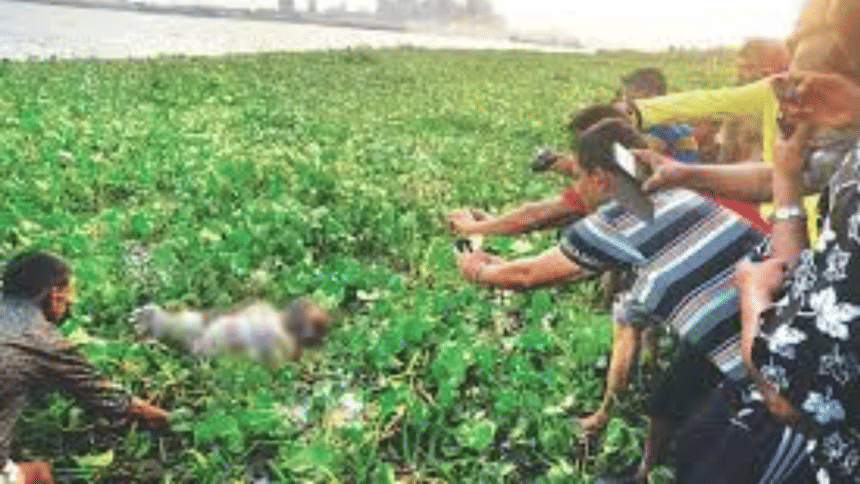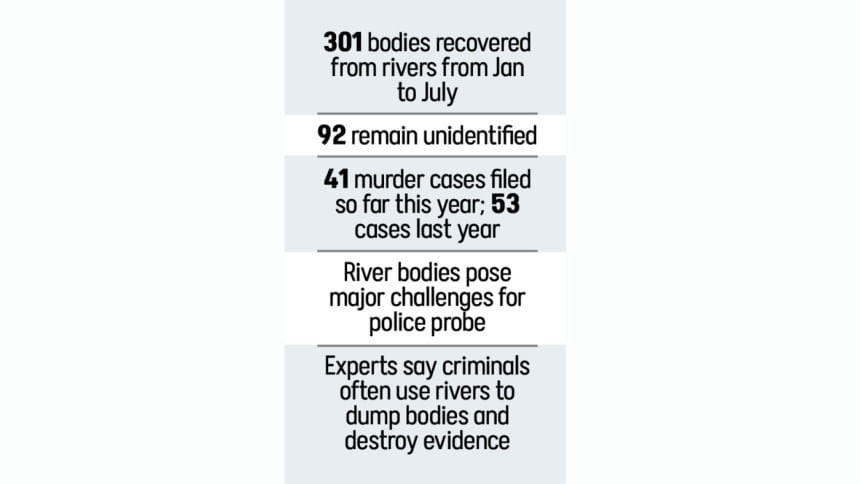43 bodies a month recovered from rivers this year

Bodies of a woman and a child were recovered from the Buriganga River on August 23. Autopsies initially found that they had been strangled before their bodies were dumped. A murder case was filed with Sadarghat River Police Station in this regard.
Police have yet to identify the victims, as their fingerprints are unidentifiable and no one has come forward to claim the bodies.
"It is necessary to identify the victims to find clues. Usually, no progress can be made without knowing who they are. We are trying," said Sohag Rana, officer-in-charge of Sadarghat Police Station, while speaking to The Daily Star.
Police sent the victims' details to various police stations to cross-check with missing persons' entries and have preserved DNA samples in case anyone comes forward.
This is a recurring challenge for police, who often struggle to identify bodies recovered from rivers. According to police and criminology experts, criminals frequently use rivers to dump bodies in an attempt to avoid arrest.
Besides, police also recover bodies of suicide or drowning victims from the rivers.
River police recovered an average of 43 bodies every month this year, compared to 36 per month last year.
Data from the River Police Headquarters shows that at least 301 bodies of men, women, and children were recovered from rivers across the country between January and July this year.
The highest number of bodies, 34, was found in Narayanganj, followed by 32 in Dhaka.

Of them, 209 were later identified, while 92 remain unidentified. Last year, at least 440 bodies were recovered from rivers, of whom 141 remain unidentified.
This year so far, at least 41 murder cases have been filed in connection with recovered bodies, compared to 53 cases last year.
River police officials said they register murder cases whenever they suspect foul play, based on the condition of the bodies and other evidence. They also acknowledged that the actual number of murder victims is likely higher.
On August 27, police recovered a headless corpse from the Shitalakkhya River in Narayanganj. With the help of the Police Bureau of Investigation, the body was identified through fingerprint matching as Habib, 27, a resident of Moddhya Kanchpur under Sonargaon upazila.
"It was a gruesome murder. The criminals had beheaded him and hidden the head elsewhere, possibly to prevent identification. The body was identified because it surfaced early and had not yet decomposed severely," said Inspector Abdul Mamud, in-charge of Kanchpur River Police Outpost.
Police officials also said decomposition of bodies in water, along with evidence damage -- sometimes from fish bites or vessel impacts -- often misleads investigators and forensic doctors during autopsies.
Typically, police file an unnatural death case after recovering a body. This case is later reclassified as a murder case if evidence of homicide is found during the investigation or through autopsy results.
Omar Faruk, a professor of criminology and police science at Mawlana Bhashani Science and Technology University, said criminals often use rivers and railway tracks to dump bodies after murders to destroy evidence and evade legal action.
"This mainly happens in cases of organised crime. The criminals usually select river areas for dumping the bodies even before committing the killings," he said.
"Many of the bodies are recovered in a heavily decomposed state, while others drift far from the victims' localities, leaving families without any clue about their fate," he added, noting that in many cases, police fail to make headway in investigations, ultimately depriving families of justice.
Abdullah Al Mamun, superintendent of Dhaka District River Police, said, "If we cannot identify any bodies or detect the case after a long time, we consult with the Police Headquarters and either hand the cases over to other agencies or submit a final report to the court."
"We preserve DNA samples to match if anyone comes forward to claim the bodies," he added.
Kusum Dewan, additional inspector general of police and chief of the River Police, said that identifying bodies is a major challenge in investigating cases and delivering justice when victims are found in rivers.
"In many cases, we cannot identify the bodies as they are often found in a decomposed state. Besides, many bodies drift from one district to another while criminals commit the murders elsewhere and dump the bodies in rivers to hide evidence," she said, adding that river police do their best to investigate each case.

 For all latest news, follow The Daily Star's Google News channel.
For all latest news, follow The Daily Star's Google News channel. 



Comments